With the evenings now starting to pull in faster and faster, we’re coming close to the end of [week night] sunset shoots.
This week, the choice was Overstrand near Cromer and thanks to Bill for not only suggesting the location but by being the only one available to join me there, which meant I was motivated and avoided the temptation to flop on the sofa.
The town of Overstrand by its architecture and vibe easily hints at a history of well-to-do (posh).
About Overstrand
Overstrand is a village (population 1,030) on the north coast of Norfolk in England, two miles east of Cromer. It was once a modest fishing station, with all or part of the fishing station being known as Beck Hythe. In the latter part of the 19th century it was catapulted into prominence, and became known as “the village of millionaires”.
The village’s name means ‘ridge shore’, or perhaps ‘narrow shore’ to contrast with nearby Sidestrand.
The London journalist and travel writer Clement Scott came to Overstrand in 1883, christened the area ‘’Poppyland’’, and wrote about the church tower on the cliff edge and its “Garden of Sleep”. While in Overstrand he stayed at the Mill House with miller Alfred Jermy and his daughter Louie, who became “the Maid of the Mill” in his articles about ‘’Poppyland’’.
Scott had many London contacts in the theatrical world, and his writings led a number of them and others from London society to come to Overstrand. Some bought land in the village and had houses built there, and for a while the village was the place to visit. A large hotel was built on the cliff edge, though this slid into the sea in the 1950s.
The Edwardian architect Sir Edwin Lutyens worked at Overstrand, designing Overstrand Hall for Charles William Mills, 2nd Baron Hillingdon, The Pleasaunce for Cyril Flower, 1st Baron Battersea and the Methodist Church.[2] The large houses of the gentry have largely passed from private ownership to other uses.
The Overstrand biplane bomber was named after the village, having been made at the Boulton & Paul aircraft factory in Norwich in the early 1930s.
Season 1, episode 2 of the BBC TV series Screen Two was called “Poppyland” (1985). Directed by John Madden, it took place in Overstrand and tells the story of Clement Scottin his travels there.
As with much of the Norfolk coast, erosion was and continues to be a major problem. Clifton Way is an experimental site; its sea defences include riprap (at £1,300 a boulder, predominantly shipped from Norway), wooden groynes, revetments, gabions and Offshore Reefs. The cliffs of soft boulder clay slump because of the water running through the clay, and the resulting material on the beach is removed by the succeeding high tides. In the neighbouring village of Sidestrand, the church was moved back from the cliff edge in the 19th century, though the tower of the church was left standing on the cliff top.
The Shoot
I arrived a minute or two after meet time thinking I was late and thought Bill might already be down on the promenade so got my wellies on, bag ready and made my down the steep slope.
The weather was overcast so there wasn’t going to be much from a sunset tonight, but there was cloud.
I had a look at the curvy sea defences as you look out to see Cromer Pier in the distance. It didn’t inspire me to consider a shot though so I decided to set up at the first groyne on offer.
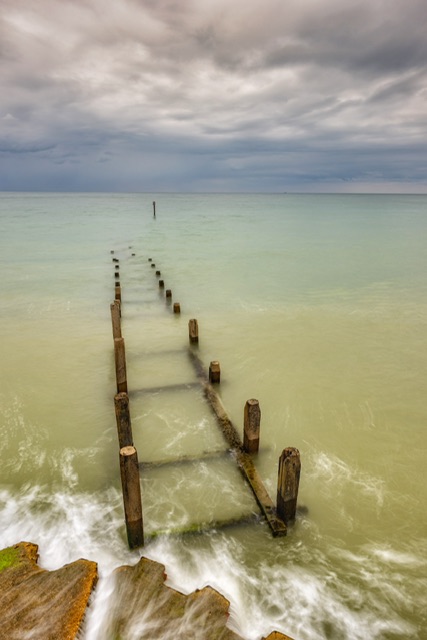
Bill joined me soon after and we began to look for some different scenes. He too had peeked at the end of the promenade at the sea defences and reassuringly also wasn’t feeling it.
He was shooting some close ups of the concrete shapes below us (you can just see them in the foreground of my shot above), so I veered left and did some handheld shots of the metallic railings with the waves crashing in.
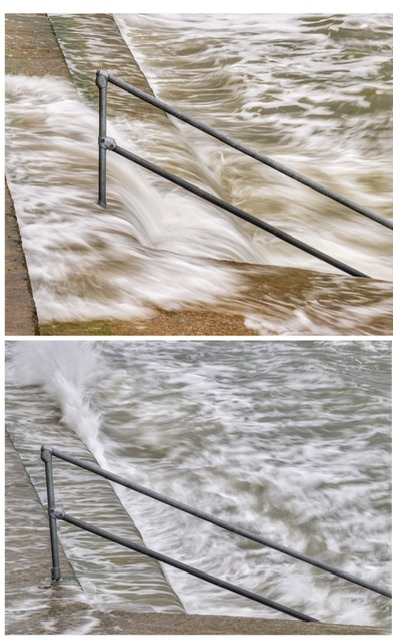
Having recently seen Gary Gough’s fine art shots from Happisburgh, I knew I’d be looking for one or two minimalist images on this trip. The single groyne posts were in my sights and Bill had cleverly taken a shot from high up on the slope to eliminate the horizon from his image.
Not wanting to copy, I took my shot from the promenade with the horizon, but made a decision to soften its appearance in post production.

I took a shot of another post and fiddled around with some different edits in post production.
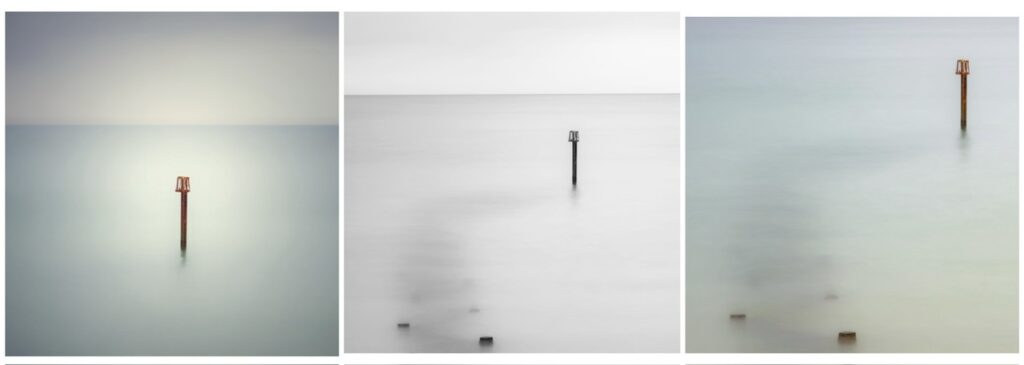
We were very much enjoying the evening and agreed that it’s easy to give up if the forecast doesn’t look great, but always worth getting out.
The odd rain shower came down during the evening but we ploughed on. When this happens, and despite so called weather sealing on my gear, I usually wipe down my camera and ensure no droplets of rain are spoiling the capture of the image by wiping the lens and any filters attached.
Weather like this also means getting your gear out when back home to dry out and avoid condensation and damp remaining which can lead to damp and mould getting into your lens elements.
It was time to move further along the promenade and we stopped at this groyne.
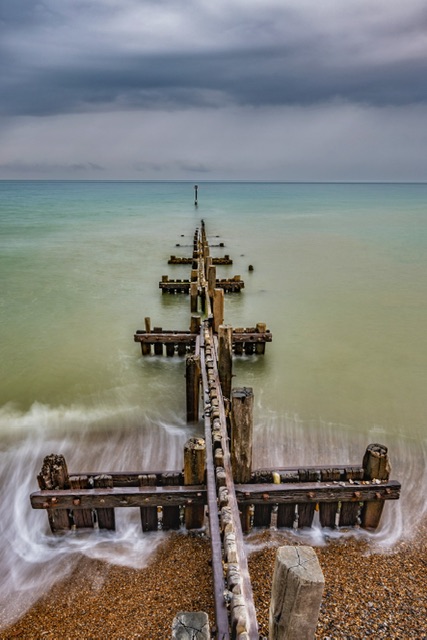
For the remaining part of the evening, we shot this groyne from left and right hand sides.
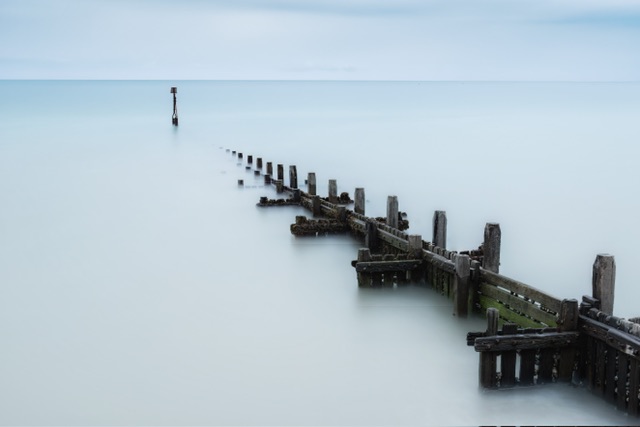

As we have all observed on the most recent evening shoots, the light now dips fast as the sunset time arrives and passes.
The light was rapidly evaporating and we weren’t far off darkness so a wrap was called, and we made our way back to the car park for a debrief.
A most enjoyable evening was had chatting, shooting and relaxing, trying different compositions, sharing opinions on various topics, watching and listening to the sea crashing in, breathing in the sea air, forgetting about things elsewhere for this moment in time.
These trips are very likely more beneficial to us than we we think.
Onwards and upwards…